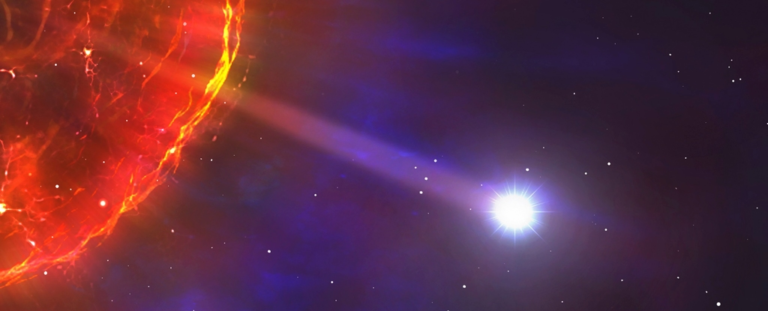Fastest Runaway Star Ever Observed in the Milky Way Detected by Scientists
In a remarkable new discovery, researchers have identified six additional runaway stars within the Milky Way, including the fastest objects of this kind ever detected in our galaxy. Among these stars, two have shattered previous records, boasting heliocentric radial velocities surpassing any measured for runaway stars to date. Star J1235 achieves an astounding speed of 1,694 kilometers (1,053 miles) per second, while J0927 reaches an astonishing 2,285 kilometers (1,420 miles) per second.
Four of the recently discovered stars belong to the category known as hypervelocity stars, traveling at speeds that exceed the escape velocity of the Milky Way. According to a team led by astrophysicist Kareem El-Badry from the Harvard-Smithsonian Center for Astrophysics, all four hypervelocity stars are likely the result of spectacular Type Ia supernovae, known as the “standard candles” by which we gauge the Universe.
This groundbreaking finding has facilitated a fresh calculation of the rate at which these stars are born, aligning with the estimated rate of Type Ia supernovae. The research outcomes have been detailed in a paper submitted to the Open Journal of Astrophysics and are available on the preprint server arXiv. The researchers note that there may still be a significant population of fainter, low-mass runaway stars awaiting discovery.

Whenever a star undergoes an explosion, the force of the detonation propels whatever remains into space at high velocities. Hypervelocity stars are believed to originate from a unique type of supernova that imparts an even greater thrust, referred to as the dynamically driven double-degenerate double-detonation, or D6, supernova. This scenario helps elucidate the events occurring during a Type Ia supernova.
The process begins with a pair of white dwarf stars in a binary system. White dwarfs are the remnants of low-mass stars that have exhausted their fusion fuel, shed most of their mass, and collapsed into a dense core emitting residual heat. These objects are classified as degenerate stars. The Chandrasekhar limit, a critical mass threshold, dictates the stability of a white dwarf. If a white dwarf exceeds this limit, approximately 1.4 times the mass of the Sun, it becomes unstable and explodes in a Type Ia supernova.
To reach this critical mass, a white dwarf must exist in close proximity to another star in a binary system. Through gravitational interaction, the white dwarf accretes matter from its companion, gradually increasing its mass over time. The outcome depends on the type of companion star. If the white dwarf draws hydrogen from its companion, it triggers a classical nova. However, if the companion is another white dwarf with a substantial helium surface layer, the accretion occurs from the helium layer.

This process results in a more massive helium layer on the surface of the donor star. When the pressure and heat within the layer reach a critical point, rapid fusion of helium into carbon ensues. This initiates a thermonuclear explosion, similar to the mechanism behind a classical nova but with an additional helium detonation. The shockwave produced by the helium detonation triggers a second detonation in the core of the white dwarf, causing a colossal explosion. This double-degenerate double-detonation phenomenon propels the donor star at extremely high velocities.
Hypervelocity stars travel at staggering speeds, exceeding 1,000 kilometers per second, which surpasses the velocity required to escape the gravitational pull of the Milky Way. Consequently, these stars are destined for intergalactic space. However, the abundance of hypervelocity stars resulting from Type Ia supernovae and their occurrence frequency remain uncertain. To address this, El Badry and colleagues turned to data from the Gaia survey, an ongoing project aimed at mapping the Milky Way with unprecedented precision, including the motions of stars as they navigate the galaxy. Through their analysis, they identified four previously unknown hypervelocity stars originating from D6 supernovae. While this may seem like a small number, when combined with the ten hypervelocity stars already known to have received a supernova kick, it provides a more accurate estimation of the prevalence of these celestial objects.

In fact, their calculations suggest that the Milky Way could have launched over 10 million hypervelocity stars into intergalactic space if a significant fraction of Type Ia supernovae produce D6 stars. Moreover, the researchers propose that numerous faint D6 stars could have been expelled from galaxies throughout the local volume passing through the Solar neighborhood.
While there exist faster stars in the Milky Way, such as those orbiting the supermassive black hole at its center, they remain gravitationally bound and unlikely to leave the galaxy. Previously, the fastest known runaway star was a D6 white dwarf binary with a velocity of approximately 2,200 kilometers per second, with its heliocentric radial velocity measured at 1,200 kilometers per second. The newfound stars J0927 and J1235 have estimated total velocities of 2,753 and 2,670 kilometers per hour, respectively.
However, the search for runaway stars is far from complete. The current observations primarily target the brightest stars, leaving a substantial number yet to be discovered. Nevertheless, this recent breakthrough offers a significant increase in data points, contributing to a better understanding of their distribution and potential detection methods.
As the researchers conclude, the presence of a sizable population of hypervelocity stars associated with thermonuclear supernovae presents an opportunity to develop models that can estimate the formation rate of these runaway stars. Additionally, a comprehensive understanding of the thermal evolution of D6 stars is crucial for more precise calculations of their birth rate. With continued advancements in astronomical research and the exploration of our galaxy, the mysteries surrounding runaway stars and their origins are gradually being unveiled.
Do not forget to share your opinion with us to provide you with the best posts !




0 Comments